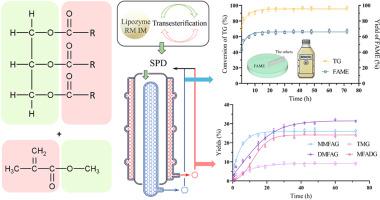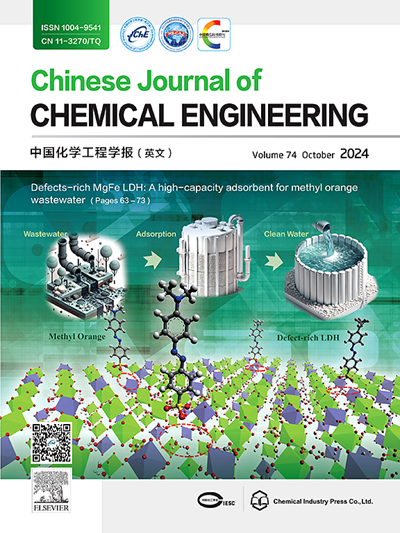Co-production of biodiesel and methacrylated fatty acid through enzymatic catalysis with methyl methacrylate as acyl acceptor
IF 3.7
3区 工程技术
Q2 ENGINEERING, CHEMICAL
引用次数: 0
Abstract
Traditional biodiesel production primarily uses methanol as the acyl acceptor, but its toxicity to lipase increases process complexity and operational difficulty elevate manufacturing costs. This study aimed to explore a new method for enzymatic synthesis of biodiesel with methyl methacrylate (MMA) as acyl acceptor. Meanwhile, a 1, 3-position specific lipase Lipozyme RM IM was applied as biocatalyst, which enables simultaneous production of biodiesel (FAMEs) and methacrylate fatty acid glycerides (MFAGs) via specific sn-1, 3 transesterification of MMA with triglyceride. Under the optimal reaction conditions: temperature of 50 °C, molar ratio of 4:1 for MMA to triglyceride, enzyme dosage of 7.5% (mass), and an extra water addition of 0.5% (mass); triglyceride conversion rate of 97%, and FAMEs yield of 65% could be obtained. Simultaneously, the multistage short-path distillation and column chromatographic method were combined used for the separation of the mixed products. Finally, the purity of FAME, MFADG, DMFAG, and MMFAG were 98%, 97.8%, 95.3%, and 81.78%, respectively. In this new approach, MMA demonstrates lower toxicity to lipases, allowing for straightforward addition of all the substrates without complex addition process, and enhancing operational feasibility. Meanwhile, the by-products of MFAGs could be applied as monomers in varnishes and protective coatings, which increased the value of the products. Thus, this investigation providing an alternative way to produce biodiesel, and providing a new pathway for the sustainable development of biodiesel.

以甲基丙烯酸甲酯为酰基受体酶法催化合成生物柴油和甲基丙烯酸酯脂肪酸
传统的生物柴油生产主要使用甲醇作为酰基受体,但甲醇对脂肪酶的毒性增加了工艺复杂性和操作难度,提高了生产成本。本研究旨在探索以甲基丙烯酸甲酯(MMA)为酰基受体酶法合成生物柴油的新方法。同时,采用1,3位特异性脂肪酶Lipozyme RM IM作为生物催化剂,通过MMA与甘油三酯的特异性sn- 1,3酯交换反应,可同时生产生物柴油(FAMEs)和甲基丙烯酸酯脂肪酸甘油三酯(MFAGs)。在最佳反应条件下:温度50℃,MMA与甘油三酯的摩尔比为4:1,酶用量为7.5%(质量),外加水用量为0.5%(质量);甘油三酯转化率为97%,FAMEs收率为65%。同时,采用多级短程精馏和柱层析相结合的方法对混合产物进行分离。最后,FAME、MFADG、DMFAG和MMFAG的纯度分别为98%、97.8%、95.3%和81.78%。在这种新方法中,MMA对脂肪酶的毒性较低,允许直接添加所有底物而无需复杂的添加过程,并提高了操作可行性。同时,MFAGs的副产物可以作为单体应用于清漆和防护涂料中,提高了产品的使用价值。因此,本研究为生物柴油的生产提供了一种替代方法,为生物柴油的可持续发展提供了新的途径。
本文章由计算机程序翻译,如有差异,请以英文原文为准。
求助全文
约1分钟内获得全文
求助全文
来源期刊

Chinese Journal of Chemical Engineering
工程技术-工程:化工
CiteScore
6.60
自引率
5.30%
发文量
4309
审稿时长
31 days
期刊介绍:
The Chinese Journal of Chemical Engineering (Monthly, started in 1982) is the official journal of the Chemical Industry and Engineering Society of China and published by the Chemical Industry Press Co. Ltd. The aim of the journal is to develop the international exchange of scientific and technical information in the field of chemical engineering. It publishes original research papers that cover the major advancements and achievements in chemical engineering in China as well as some articles from overseas contributors.
The topics of journal include chemical engineering, chemical technology, biochemical engineering, energy and environmental engineering and other relevant fields. Papers are published on the basis of their relevance to theoretical research, practical application or potential uses in the industry as Research Papers, Communications, Reviews and Perspectives. Prominent domestic and overseas chemical experts and scholars have been invited to form an International Advisory Board and the Editorial Committee. It enjoys recognition among Chinese academia and industry as a reliable source of information of what is going on in chemical engineering research, both domestic and abroad.
 求助内容:
求助内容: 应助结果提醒方式:
应助结果提醒方式:


